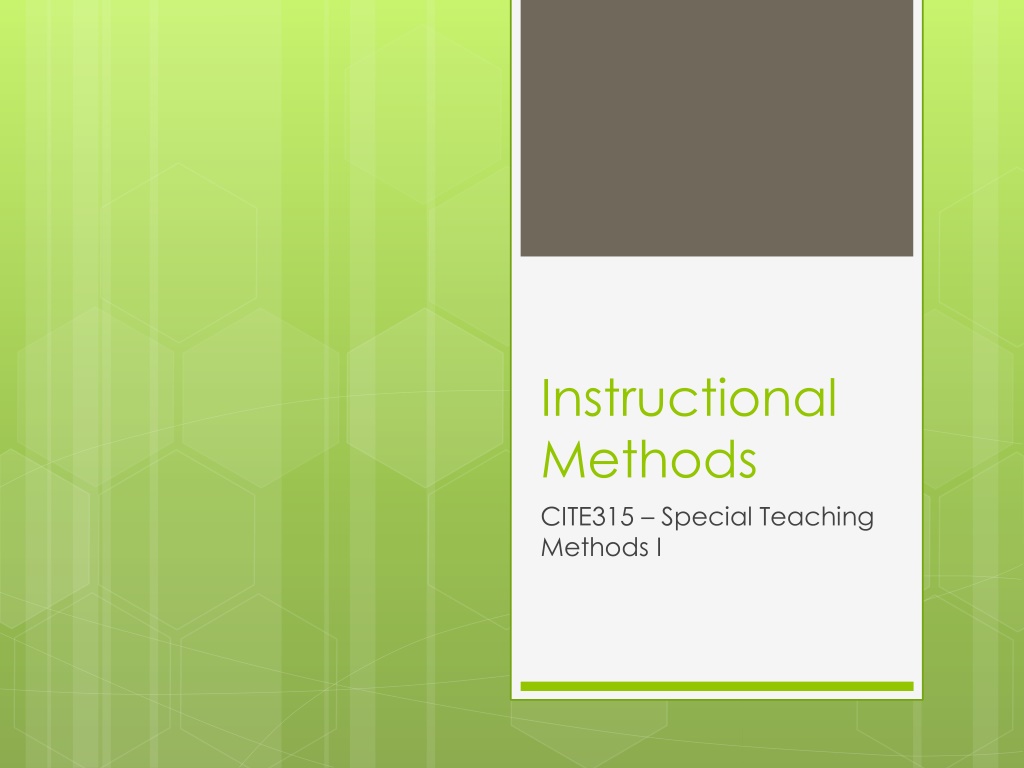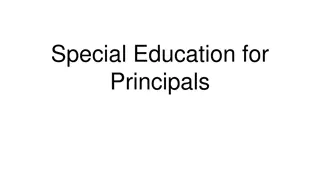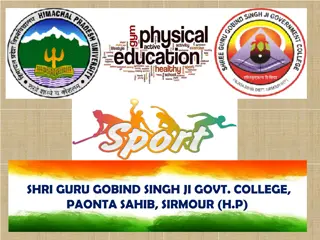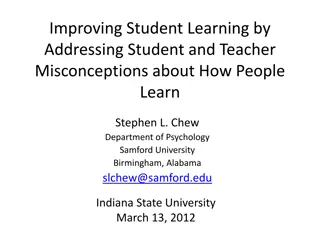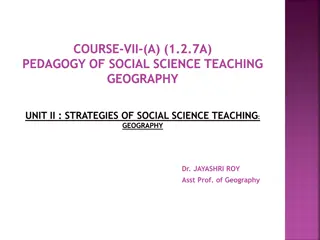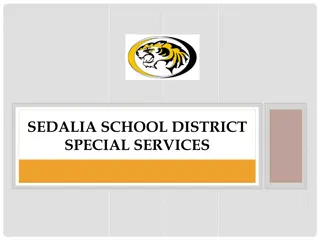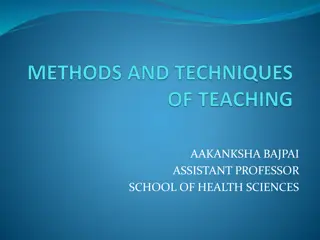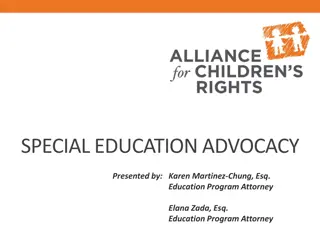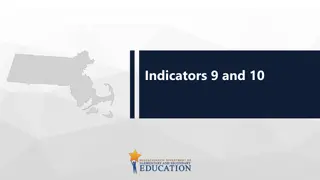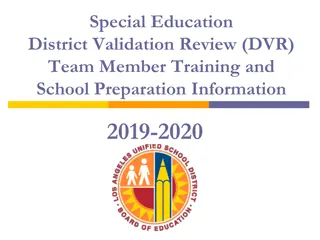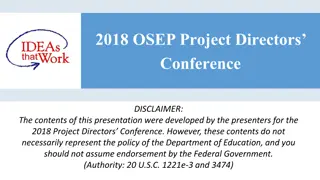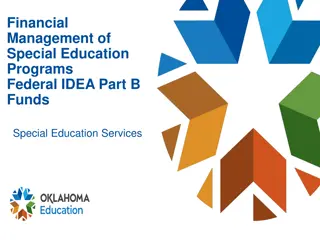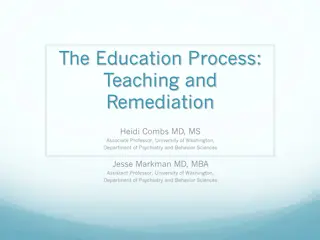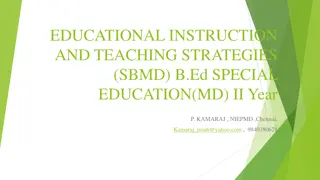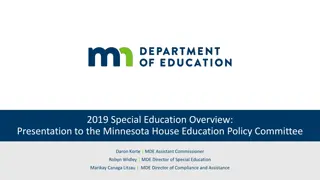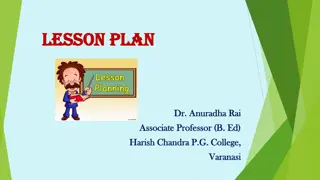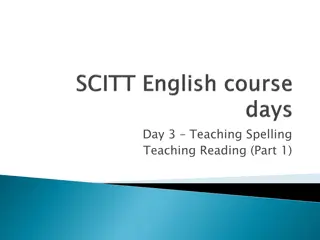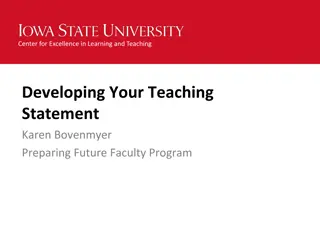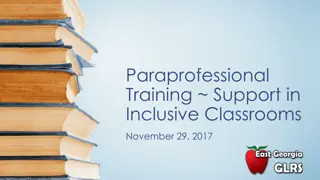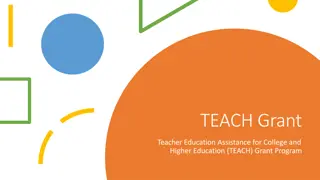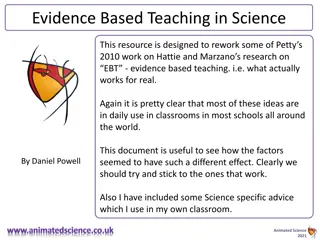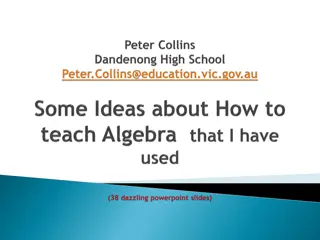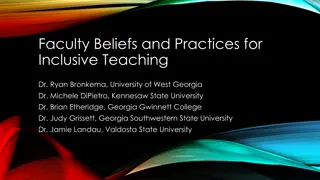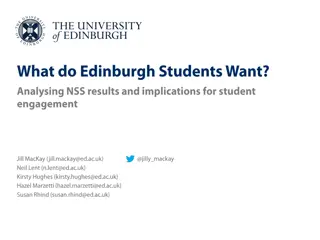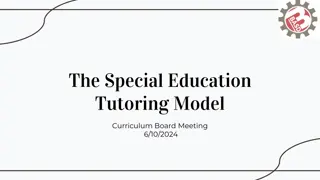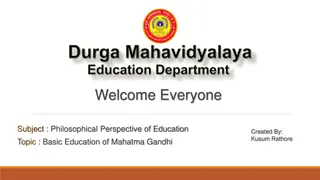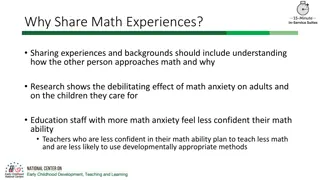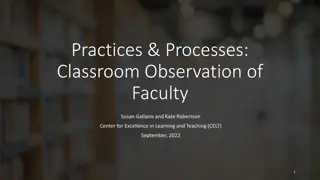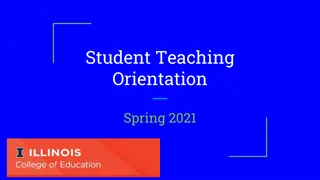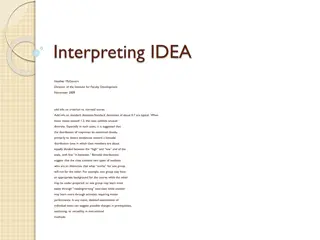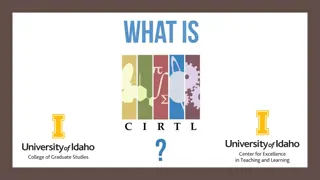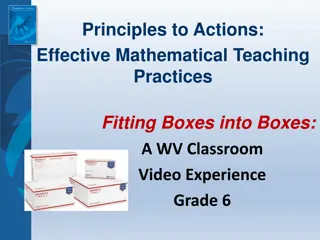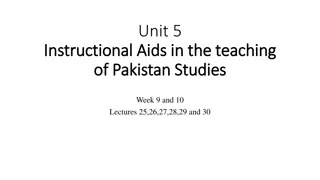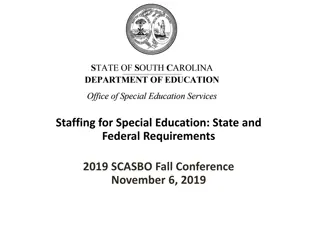Effective Teaching Methods for Special Education
In this set of resources, you will explore the Direct Instruction Method, which encompasses explicit teaching strategies to effectively convey both concepts and skills. You will delve into the roles of both teachers and students within this method, as well as the characteristics and benefits of Direct Instruction. Additionally, you will learn about the Demonstration Method and its focus on achieving psychomotor and cognitive objectives through structured steps.
Download Presentation

Please find below an Image/Link to download the presentation.
The content on the website is provided AS IS for your information and personal use only. It may not be sold, licensed, or shared on other websites without obtaining consent from the author. Download presentation by click this link. If you encounter any issues during the download, it is possible that the publisher has removed the file from their server.
E N D
Presentation Transcript
Instructional Methods CITE315 Special Teaching Methods I
Direct Instruction Method Also called explicit instruction Widely applicable strategy that can be used to teach both concepts and skills Uses teacher explanation and modeling combined with student practice and feedback
Teacher Role Specifies learning objectives procedural skills; automaticity; transfer Explains and illustrates content Models skills
Student Role Active in responding to teacher questions Analyzing examples Practicing skills to mastery
Direct Instruction Defined DI is academically focused, teacher- directed instruction that uses sequenced and structured materials Goals are clear to students Coverage of content is extensive Performance of students is monitored Feedback is immediate
Characteristics of Direct Instruction Reviewing the previous day s work Presenting new material in clear and logical steps Providing guided practice Giving feedback with correctives Providing independent practice Reviewing to consolidate learning
Focus, Structure and Principles Demonstration Strategy focus to achieve psychomotor and cognitive objectives. If we talk about its structure, it is given in three successive steps:
Focus, Structure and Principles Introduction: In this step objectives of the lesson are stated. The teacher may be called demonstrator. He demonstrates the activity before the student that is to be developed.
Focus, Structure and Principles Development. Students try to initiate the demonstrated activity. If there is any query the teacher tries to satisfy them by further demonstration and illustrations.
Focus, Structure and Principles Integration. At this step, the teacher integrates all the activities and then these activities are rehearsed revised and evaluated.
Principles This teaching strategy is based on the following principles Learning by doing maxim is followed Skills can be developed by limitation The perception helps in imitation
Advantages of Demonstration Method It helps in involving various sense to make learning permanent Though, teacher behavior is autocratic, he invites the cooperation of pupils in teaching learning process
Advantages of Demonstration Method It develops interest in the learners and motivates them for their active participation It helps in achieving psychomotor objectives
Disadvantages of Demonstration Method It can be used only for skills subjects Only the attention of the learners is invited towards the activity demonstrated. They are not free to discuss about it
Disadvantages of Demonstration Method Due to poor economic conditions of the government schools, there is scarcity of audio-visual aids and equipment and the teachers are not so creative to produce handmade models for demonstration
Disadvantages of Demonstration Method There is a general lack of sincerity and diligence among teachers who wish to complete the syllabus or syllabi at the earliest without putting sincere efforts
Question-Answer Method (Socratic Method) Question answer teaching strategy is an old strategy also known as Socratic Method of teaching . It was developed by the famous philosopher Socrates. According to Parke, the question is the key to all educative activity above the habit-skill level.
Question-Answer Method (Socratic Method) This strategy is focused on to achieve the cognitive objectives and bringing knowledge to the conscious level. It has the following principle: Theory of unfoldment, all knowledge is within the child, teacher cannot teach any ting from outside The knowledge can be emitted by linking the questions with his answers
Steps of Question-Answer Method To prepare questions and arrange them in a logical sequence To present the questions in such a way that curiosity arises among the learners To ask new questions by linking with the learners response
Advantages of Question- Answer Method While asking questions, the teacher keeps in mind the abilities, needs and interest of the learner. It involves the learners participation towards the subject matter and in teaching acts. It helps in achieving cognitive objectives and bringing knowledge at conscious level. Classroom verbal interaction is encouraged It is a useful strategy at all the levels of education
Disadvantages of Question- Answer Method It is difficult to prepare good questions, and arrange them logically. The whole content-matter cannot be taught by this strategy The teacher wants the structured answers from the learners. There is no freedom for imaginative answers.
Suggestions Instead of using it independently, this teaching strategy should be supplemented by lecture and demonstration method of teaching. The teacher should be skilled in framing proper questions and language of the questions should be clear and unambiguous. The teacher should distribute the questions to the whole class evenly.
Case Study Teaching Method The Case Study Method is based on focused stories rooted in reality providing contextual information such as background, characters, setting, and enough specific details to provide some guidance.
Case Study Teaching Method Cases can be used to illustrate, remediation, and practice critical thinking, teamwork, research, and communication skills.
Case Study Teaching Method Classroom applications of the case study method include: Socratic cross-examination directed discussion symposia or debates public hearings or trials research teams term papers dialogue paper
Categories of Case Studies Open or Closed: Open cases are left to one s interpretation and may have multiple correct or valid answers depending on the rationale and facts presented in the case analysis. Closed cases have specific, correct answers or processes that must be followed in order to arrive at the correct analysis.
Categories of Case Studies Analysis or Dilemma: Analysis Cases (Issues Cases) are a general account of what happened . Dilemma Cases (Decision Cases) require students to make a decision or take action given certain information.
Case Study Analysis Procedure There is four basic stages students follow in analyzing a case study. Observe the facts and issues that are present without interpretation ( what do we know ). Develop hypotheses/questions, formulate predictions, and provide explanations or justifications based on the known information ( what do we need to know ).
Case Study Analysis Procedure There is four basic stages students follow in analyzing a case study. Collect and explore relevant data to answer open questions, reinforce/refute hypotheses, and formulate new hypotheses and questions. Communicate findings including citations and documentation.
How to Write a Case Study Identify a course and list the teachable principles, objectives, topics, and issues (often times, a difficult or complex concept students just don t get ) List any relevant controversies and subtopics that further describe your topics
How to Write a Case Study Identify stakeholders or those effected by the issue (from that list, consider choosing one central character on which to base the case study) Identify teaching methods that might be used (team project, dialogue paper, debate, etc.) as well as the most appropriate assessment method (peer or team assessments, participation grade, etc.)
How to Write a Case Study Decide what materials and resources will be provided to students Identify and describe the deliverables students will produce (paper, presentation, etc.)
How to Write a Case Study Select the category of case study (open or closed/analysis or dilemma) that best fits your topic, scenario, instructional objectives, teaching method, and assessment strategy. Write your case study and include teaching notes outlining the critical elements identified above Teach the case and subsequently, make any necessary revisions
Collaborative Learning Collaborative learning is an educational approach to teaching and learning that involves groups of students working together to solve a problem, complete a task, or create a product.
Collaborative Learning According to Gerlach, "Collaborative learning is based on the idea that learning is a naturally social act in which the participants talk among themselves (Gerlach, 1994). It is through the talk that learning occurs."
Collaborative Learning Assumptions Learning is an active process Learning requires a challange (process information rathen than memorize) Learners benefit from different opinions Learners succeed in a social environment Learners had to present and defend their ideas.
Collaborative Learning Strategies Think-pair share Instructor asks a question to pair of students. Question should be difficult (analysis, evaluation, synthesis). Students discuss the question with their partner. Students responses are shared with whole class members.
Collaborative Learning Strategies Three-step interview One student interview with the other Second student interview with the first one (role switching) Information is discussed within group members or whole class.
Collaborative Learning Strategies Simple jigsaw An assignment is divided into four parts. Each part is assigned to a student, so student becomes expert on his/her part. Student then work together and discuss the assignment as a whole. Each student teach his/her part to others. At the end, all parts are brought together to have whole single assignment.
Collaborative Learning Strategies Roundtable Instructor asks questions and give students time for finding answers. Each group is provided with paper and pen Each student writes his/her response on a paper. When times up, students start to discuss their answers and come up with one solution or multiple solutions.
What comes to your mind about online collaborative learning strategies?
References http://books.google.com.cy/books?id=aKuEYJdG yTIC&printsec=frontcover&hl=tr http://www.pearsoncustom.com/ufl_ctsm/ppts/dir ect_instruct.ppt http://books.google.com.cy/books?id=ODPzFCSv k4MC&printsec=frontcover&hl=tr http://www.studylecturenotes.com/curriculum- instructions/demonstration-method-of-teaching- meaning-advantages-disadvantages http://www.studylecturenotes.com/curriculum- instructions/question-answer-method-of-teaching- %7C-socratic-method-of-teaching
References http://books.google.com.cy/books?id=1EMkK nIbO4YC&printsec=frontcover&hl=tr http://elearning.missouri.edu/teaching-with- the-case-study-method/ http://www.wcer.wisc.edu/archive/cl1/CL/m oreinfo/MI2A.htm http://www.gdrc.org/kmgmt/c- learn/strategies.html http://onlinelearningtips.com/wp- content/uploads/2013/09/collaborative- learning-online-ed.jpg
